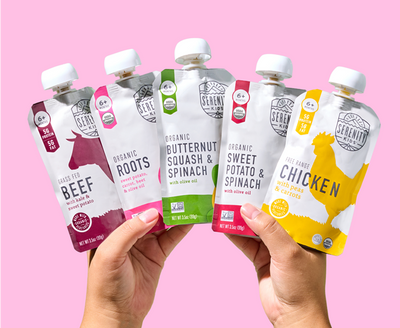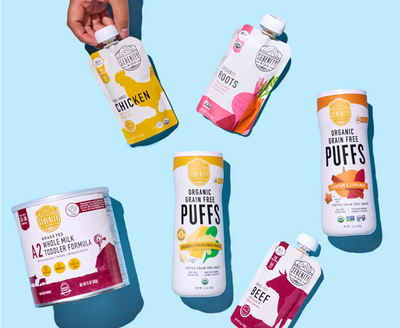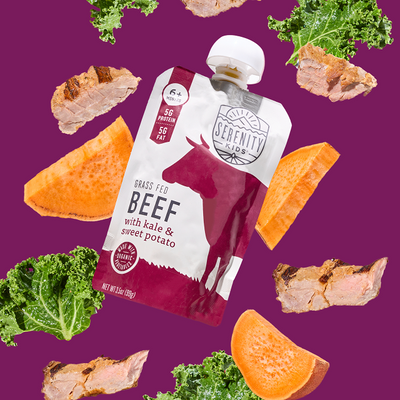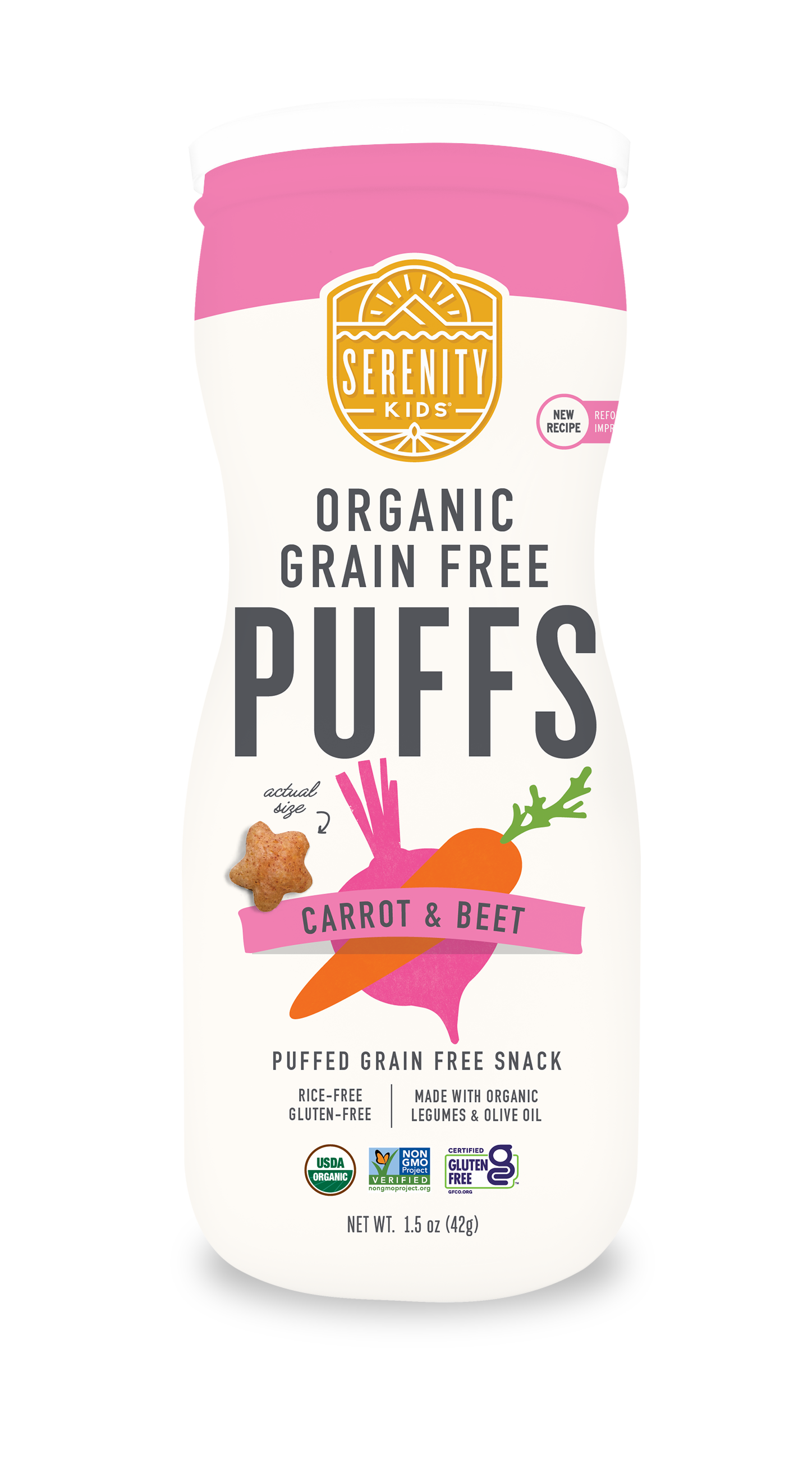In the early days of Serenity Kids, one of our many decisions was whether or not to offer entirely organic products. The decision was simple for our veggies, as the benefits of organic vegetables are clear. But when it came to meat, the decision wasn’t so straightforward.
We did a whole lot of research and learned that the BEST animal farmers were not able to get organic certification. That’s because the existing organic certification was fundamentally designed for plants, where humans control 100% of the inputs.
The only way to certify meat organic is to treat the animals like plants, put them in pens and feed them exclusively organic grain. The new “regenerative organic” certification shares these same limitations and is currently only being applied to plants, not animals.
Since animals in pens with a strictly controlled diet is not the way nature intended for animals to eat or live, it creates inferior quality meat, an unpleasant life for the animal, and environmental devastation.
So we decided to forgo organic certification on our products to support farmers creating meat that is nutritionally superior and better for the animal and environment. Enter regenerative farming.
What is regenerative agriculture?
Regenerative agriculture is the term for farming and ranching practices that improve soil health so that it removes carbon from the atmosphere and puts it back in the soil. To put regenerative agriculture in perspective, it’s helpful to look at the different types of agricultural practices that exist today.
- Degenerative - focused on output at any cost to the environment (industrial farming)
- Sustainable - focused on doing no harm to the environment
- Regenerative - focused on making the land better
In short, regenerative agriculture actually improves the land and environment instead of maintaining or damaging it.
The key principles of regenerative agriculture are widely understood to include:
- Minimize the physical, biological, and chemical disturbance of the soil.
- Keep the soil covered with vegetation or natural material.
- Increase plant diversity.
- Keep living roots in the soil as much as possible.
- Integrate animals into the farm as much as possible.
In other words, it’s implementing agricultural practices the way that our ancestors practiced for the vast majority of history before disruptive and damaging industrial agriculture practices took over much of our farmland in an attempt to increase yields.
What organic farming is missing compared to regenerative agriculture
Organic farming focuses on certifying practices rather than results. What we mean by this is that organic farmers are bound by a set of rules that they must follow, but these rules lack accountability when it comes to the results that they ultimately produce. While organic certification is a step in the right direction to eliminating pesticides and implementing certain positive practices, it is not enough to support the longevity of our land, the health and wellbeing of our farmers and their livestock, and the sustainability of our Earth.
Regenerative farming focuses on reducing greenhouse gas emissions and improving the land on which they raise animals and grow plants.
Why is regenerative agriculture better for animals?
Regenerative agriculture practices allow animals to graze rather than giving them traditional feed and limited physical mobility. It essentially enables animals to live as they were intended to live, and how they live in their natural habitats even today. It’s a more humane way to treat them and a more nutrient-rich diet to feed them.
Furthermore, research has shown that animals foraging on phytochemically diverse pastures require fewer anthelmintics (antiparasitics) and antibiotics than animals foraging on monoculture pastures or in feedlots.
Why is regenerative agriculture better for farmers?
When farmers and ranchers practice regenerative agriculture, the health and productivity of both animals and the land improve. Furthermore, farmers and ranchers are not exposed to the toxic chemicals and fumes that are detrimental to their health.
In addition, when farmers and ranchers have a diversity of plants and animals, they can generate income on different time horizons rather than being dependent on a single season to produce income.
Why does regenerative agriculture result in meat with better nutrition?
The bottom line is that when animals are treated as nature intended, they are healthier animals, and healthier animals produce more nutritious meat.
In fact, research has shown that cows raised on pasture have an optimal Omega-3 to Omega-6 ratio. (More on why this ratio is so important here!) In addition, pigs and poultry raised on pasture have been shown to contain healthy monounsaturated fat levels, as well as higher amounts of protein and collagen than their conventional counterparts.
In addition, research has shown that animals grazing on diverse pastures like those on regenerative farms accumulates both higher amounts and a wider variety of phytochemicals in their meat and milk compared to animals grazing in non-diverse (monoculture) pastures. Concentrations of phytochemicals are even further reduced (and often completely undetected!) in the meat of animals fed grain-based diets in feedlots.
How is regenerative agriculture better for the planet, specifically reversing climate change?
Regenerative agriculture focuses on several practices that have been studied for their ability to sequester greenhouse gas emissions and reverse climate change:
- Managed grazing: rather than industrial practices like pesticides and chemicals, fostering natural animal grazing enhances biodiversity from microbes in soil to plants, insects, fish, birds, and mammals (including the farm’s livestock)
- Silvopasture: an ancient practice that integrates trees and pasture into a single system for raising livestock, research suggests silvopasture far outpaces any grassland technique for counteracting the methane emissions of livestock and sequestering carbon under-hoof. Pastures with trees sequester five to ten times as much carbon as those of the same size that are treeless, storing it in both biomass and soil.
- Tree intercropping: similar to silvopasture, tree intercropping involves the intermingling of trees and crops. This increases the carbon content of the soil and the productivity of the land. Benefits include windbreaks which reduce erosion and create habitat for birds and pollinators, protection of fast-growing annuals, cultivation of deep-rooted plants that can draw up minerals and nutrients for shallow-rooted ones, and protection of light-sensitive crops.
- Conservation agriculture aims to “keep the soil together” as a living ecosystem by minimizing soil disturbance, maintaining soil cover, and managing crop rotation. Farms practicing conservation agriculture do not use plows or tilling, as this causes the water in the freshly turned soil to evaporate. The soil itself can be blown or washed away and carbon held within it is released into the atmosphere. Tilling can make a field nutrient-poor and less life-giving.
- Farmland restoration: A tremendous amount of farmland has been “farmed out” which can result in increased emissions from eroding soil. Bringing these lands back into productive use can help turn them into carbon sinks (land that absorbs more carbon from the atmosphere than it releases).
We walk the talk
We are proud to partner with Land to Market, an organization that helps companies who strive to support regenerative agriculture by connecting them with verified farmers and ranchers that meet their sourcing needs. Land to Market saves both companies and regenerative farmers the time required to vet each other and market their products, making the entire supply chain more efficient.
Buying Serenity Kids products might seem like a small step, but the truth is, your impact is huge. You’re not only supporting regenerative farmers and ranchers, you’re also influencing the health of our planet today and the future of the environment for your little ones (and generations to come!) We celebrate Mama Earth every day through ethical sourcing ✔️regenerative agriculture ✔️American farms ✔️eco-friendly packaging ✔️and a TerraCycle partnership ✔️ in addition to making babies healthier, we are committed to leaving them a healthier planet, and we’re thrilled you're right here alongside us in our mission.
Sources
Paustian, K. et al. (2020). Climate Mitigation Potential of Regenerative Agriculture is significant! (PDF).
Is Grassfed Meat and Dairy Better for Human and Environmental Health?
https://drawdown.org/solutions/
https://sustainabledish.com/meat-is-magnificent/
https://www.frontiersin.org/articles/10.3389/fsufs.2020.555426/full















































